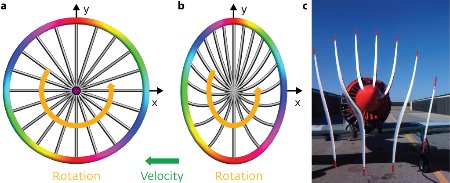Aug. 10, 2012 Research Highlight Physics / Astronomy
Rotations at the speed of light
An effect occurring for rotating objects at the speed of light has surprising relevance to everyday applications
 Figure 1: Relativistic flywheel (a and b): When a round flywheel (a) moves horizontally, close to the speed of light, it appears distorted to an observer (b). The rolling-shutter effect (c): CMOS camera chips are continuously read out from left to right of the image. This can lead to distortions of fast-moving objects that are strikingly similar to the relativistic Hall effect. Reprinted, with permission, from Ref. 1 © 2012 American Physical Society
Figure 1: Relativistic flywheel (a and b): When a round flywheel (a) moves horizontally, close to the speed of light, it appears distorted to an observer (b). The rolling-shutter effect (c): CMOS camera chips are continuously read out from left to right of the image. This can lead to distortions of fast-moving objects that are strikingly similar to the relativistic Hall effect. Reprinted, with permission, from Ref. 1 © 2012 American Physical Society
It is tempting to believe that effects arising from Einstein’s theory of relativity, where objects move at speeds close to the speed of light, arise mainly at very large length scales, for example the movement of planets and stars. However, as Konstantin Bliokh and Franco Nori from the RIKEN Advanced Science Institute have demonstrated, this is not necessarily so. The researchers have shown that a combination of relativistic motions and rotation effects can lead to a rather general phenomenon that occurs for a range of objects, from black holes to small beams of light or electrons1.
When an object is moving close to the speed of light, relativistic effects occur. For example, to an external observer an object moving very fast appears squeezed in the direction of the object’s motion (Fig. 1). This so-called Lorentz contraction arises from the timing in which light from the fast-moving object arrives at the observer. Bliokh and Nori have now shown that if such an object also rotates at the same time, for example a flywheel, then the rotating motion is also affected. The spokes in the wheel appear distorted in a way that makes them seem denser in one direction than the other. This is a general effect. For electron beams for example, it would appear as if the electrons accumulate mainly on one side. Hence, this effect has been named a relativistic Hall effect, as it is an analog of the usual Hall effect, where moving electrons in a magnetic field accumulate on one side of a material.
The effect on the spokes of a wheel bears a striking similarity to a problem in conventional photography known as the rolling-shutter effect. There, the way a CMOS-based image sensor, in for example a mobile phone camera, is continuously read out from one side to the other causes distortions that look very similar to the spokes of a flywheel. “The rolling shutter effect emulates the relativistic deformations as it introduces a mathematically very similar time delay to an object as the relativistic effects,” explains Bliokh.
Such analogies to photo and video cameras might also point to wider possibilities of observing the relativistic Hall effect in real-world systems that are mathematically identical to relativistic motions. But it is applicable to truly relativistic systems as well. “The relativistic Hall effect can play a role in astrophysical systems involving rotating black holes or vortex-like beams of light,” says Nori.
References
- 1. Bliokh, K.Y. & Nori, F. Relativistic Hall effect. Physical Review Letters 108, 120403 (2012). doi: 10.1103/PhysRevLett.108.120403
